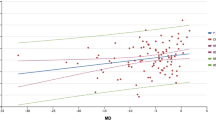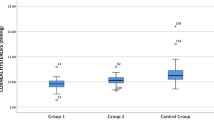Abstract
Rosacea is a chronic cutaneous disorder which is known to cause inflammation and increased proteolytic activity on the ocular surface that might lead to corneal biomechanical alterations. The aim of this study is to evaluate the corneal biomechanical properties of ocular rosacea patients and compare the measurements with healthy individuals as measured with Reichert ocular response analyser (ORA). Besides full eye examination [best corrected visual acuity (BCVA), intraocular pressure (IOP) measured with Goldmann applanation tonometry (IOP-G)], central corneal thickness (CCT), and ORA [corneal hysteresis (CH), corneal resistance factor (CRF), corneal compensated IOP (IOPcc), Goldmann correlated IOP (IOPg)] measurements of 30 eyes of 15 ocular rosacea patients (study group) and 30 eyes of 15 healthy individuals (control group) were performed. For comparisons paired t test was used. Mean age of study group was 45.26 ± 11.65 (range 25 and 63) and control group was 45.00 ± 8.91 (range 26 and 58) years (p = 0.865). No significant difference in BCVA, CCT, IOP-G, IOPcc was detected among groups. However, IOPg, CH, and CRF in the study group were significantly lower than in the control group (p = 0.013, p = 0.013, p = 0.009, respectively). IOPg, CH, and CRF parameters of ocular rosacea patients were significantly lower than normal individuals. These differences and their probable clinical reflections that might effect making decisions in conditions such as glaucoma should be investigated in larger number of patients.
Similar content being viewed by others
References
Wilkin J, Dahl M, Detmar M, Drake L, Feinstein A, Odom R et al (2002) Standard classification of rosacea: report of the National Rosacea Society Expert Committee on the Classification and Staging of Rosacea. J Am Acad Dermatol 46:584–587
Ghanem VC, Mehra N, Wong S, Mannis MJ (2003) The prevalence of ocular signs in acne rosacea: comparing patients from ophthalmology and dermatology clinics. Cornea 22:230–233
Akpek EK, Merchant A, Pinar V, Foster CS (1997) Ocular rosacea: patient characteristics and follow-up. Ophthalmology 104:1863–1867
Alvarenga LS, Mannis MJ (2005) Ocular rosacea. Ocul Surf 3:41–58
Kocak-Altintas AG, Kocak-Midillioglu I, Gul U, Bilezikci B, Isiksacan O, Duman S (2003) Impression cytology and ocular characteristics in ocular rosacea. Eur J Ophthalmol 13:351–359
Palamar M, Degirmenci C, Ertam I, Yagci A (2015) Evaluation of dry eye and meibomian gland dysfunction with meibography in patients with rosacea. Cornea 34:497–499
Abdelfattah NS, Dastiridou A, Sadda SR, Lee OL (2015) Noninvasive imaging of tear film dynamics in eyes with ocular surface disease. Cornea 34(Suppl 10):S48–S52
Shah S, Laiquzzaman M, Cunliffe I, Mantry S (2006) The use of Reichert ocular response analyser to establish the relationship between ocular hysteresis, corneal resistance factor and central corneal thickness in normal eyes. Cont Lens Anterior Eye 29:257–262
Rosa N, Lanza M, De Bernardo M, Signoriello G, Chiodini P (2014) Relationship between corneal hysteresis and corneal resistance factor with other ocular parameters. Semin Ophthalmol 30:335–339
Onaran Z, Karabulut AA, Usta G, Örnek K (2012) Central corneal thickness in patients with mild to moderate rosacea. Can J Ophthalmol 47:504–508
Dursun D, Piniella AM, Pflugfelder SC (2001) Pseudokeratoconus caused by rosacea. Cornea 20:668–669
Odom R, Dahl M, Dover J, Draelos Z, Drake L, Macsai M et al (2009) Standard management options for rosacea, part 2: options according to subtype. Cutis 84(2):97–104
Stone D, Chodosh J (2004) Oral tetracyclines for ocular rocasea: an evidence-based review of the literature. Cornea 23(1):106–109
Afonso AA, Sobrin L, Monroy DC, Selzer M, Lokeshwar B, Pflugfelder SC (1999) Tear fluid gelatinase B activity correlates with IL-1alpha concentration and fluorescein clearance in ocular rosacea. Invest Ophthalmol Vis Sci 40:2506–2512
Medeiros FA, Meira-Freitas D, Lisboa R, Kuang TM, Zangwill LM, Weinreb RN (2013) Corneal hysteresis as a risk factor for glaucoma progression: a prospective longitudinal study. Ophthalmology 120:1533–1540
Yildirim Y, Olcucu O, Agca A, Karakucuk Y, Alagoz N, Mutaf C, Demirok A, Kutlubay Z (2015) Topographic and biomechanical evaluation of corneas in patients with ocular rosacea. Cornea 34:313–317
Firat PG, Doganay S (2011) Corneal hysteresis in patients with dry eye. Eye 25:1570–1574
Funding
None.
Author information
Authors and Affiliations
Corresponding author
Rights and permissions
About this article
Cite this article
Palamar, M., Degirmenci, C., Ertam, I. et al. Ocular response analyser measurements and central corneal thickness in ocular rosacea patients. Int Ophthalmol 37, 7–11 (2017). https://doi.org/10.1007/s10792-016-0218-3
Received:
Accepted:
Published:
Issue Date:
DOI: https://doi.org/10.1007/s10792-016-0218-3




